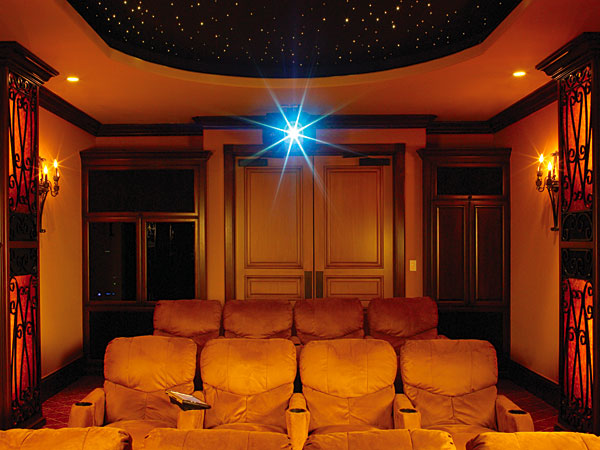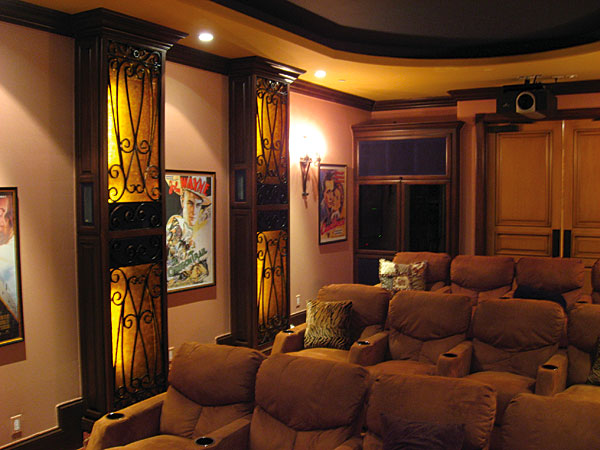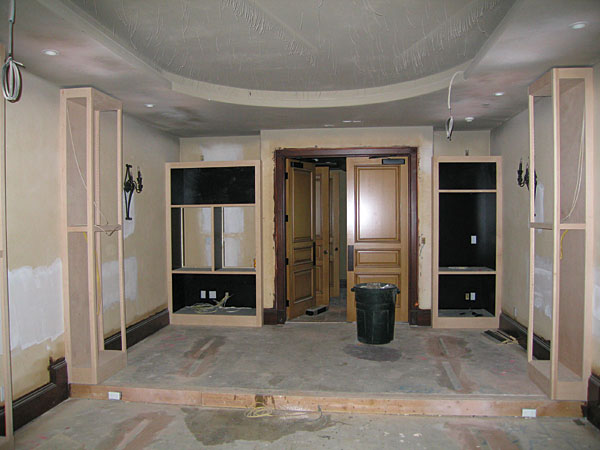Outside of the Box

When you think about growing old with your significant other, you probably think of retiring to a secluded community and maybe traveling together. But did you ever consider home theater as part of your future plans? It is for this couple in Chino Hills, California, who had the luxury of building their dream house—the house they will eventually retire in. They fitted it with all the amenities they know they will want down the road. Thinking long-term, they installed a complete home-automation system with lighting control, security cameras, an alarm system, climate control, and wholehouse audio, as well as a putting green and an elevator. Their plan also includes a dedicated home theater on the bottom level of their home, where they can enjoy their favorite movies in a perfectly controlled environment.
Making for an interesting installation, the homeowners brought in Josh Christian of DSI Entertainment Systems after they'd allocated the space for the theater. "We were about six months too late for the planning stages and had to work within the confines of what was available," says Christian. "The theater room was square. Standing-wave acoustic problems are much worse if the room dimensions are square or divisible by one another." Luckily, the room adjacent to the space originally planned for the theater, which was designated as the gym on the blueprints, was rectangular. Christian persuaded the clients to switch the rooms and use the room with the more acoustic-friendly dimensions as the theater. The homeowners agreed.


Secret Room, Superior Sound
Still, the room had a design issue: "There was a jog in the wall, so the room wasn't a perfect rectangle," says Christian. He decided to think outside of the box and used that jog to form a false fabric structure that would serve as the screen wall. This would create a hidden room behind, accessible by a hidden doorway to the right of the screen and behind the curtain. The false wall is covered with acoustically transparent fabric, so the speakers housed behind it can fire through unhindered.

The homeowners had only one parameter: They wanted to use M&K speakers based on previous good experience with them, and they wanted the sound to blow them away. The false wall was a blessing in disguise, as it allowed enough space behind the screen for ideal speaker positioning. Normally, space constraints behind the screen force you to place the speakers right up against the wall. However, "front-channel speakers are designed to be positioned a few feet from the wall," says Christian. "If not, the voices sound honky or otherwise distorted because the midbass is boosted. Many speakers have a boundary-compensation switch to compensate for this dynamic, but the M&K 150 monitors we used don't. Because of the generous depth of the hidden room, we were able to move the speakers 4 to 5 feet away from the wall, which is similar to placement in an audiophile setup. You get great front-to-back imaging, and the speakers are totally hidden."

Christian, having recently studied the latest acoustical research from sound guru Floyd Toole, wanted to install four subwoofers instead of one. "If you don't use several subwoofers and equalize the bass, the bass at different seats is going to sound varied," says Christian. The M&K LCRs, with two M&K MX-350 subwoofers, took care of the front part of the room. For the rear subwoofers, DSI installed two more MX-350 subwoofers in the lower cabinets on both sides of the doorway cabinetry at the back of the room. The tops of the cabinets on both sides are filled with Von Schweikert TS-150 surround speakers. (This model has since been discontinued by the manufacturer.) Two more are hidden in custom wood columns at the sides of the room. They feature backlit mica panels and wrought iron above and below the speaker niches.

The secret room also houses an equipment rack with two Meridian G57 amps and a balanced G68XXV digital preamp. Christian used the preamp's DSP room-correction mode to tighten up the sound. To do this, an installer simply wires a sound-pressure meter and a laptop to the back of the preamp, which then sends out test tones to the speakers in a preset sequence. The computer then downloads the data and figures out which bass frequencies have problems. "Every enclosed room has standing waves and gets boomy at certain frequencies," says Christian. "The Meridian works by shortening the time that these frequencies are played back. You hear cleaner, tighter bass, and that boom frequency is not noticeable." Also, the secret room is entirely acoustically absorptive, so you don't hear any equipment noise when you sit in the audience.
























































